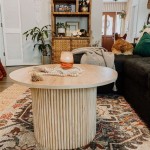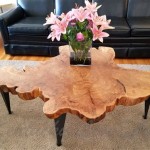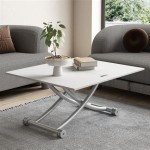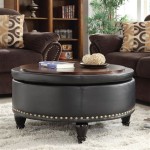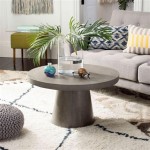Tiny Coffee Tables: Maximizing Style and Functionality in Small Spaces
In contemporary interior design, the challenge of optimizing space is paramount, particularly in urban dwellings and smaller homes. The coffee table, traditionally a central fixture in living rooms, often presents a spatial hurdle. This necessitates the exploration of alternatives that offer functionality without sacrificing precious square footage. Tiny coffee tables emerge as a strategic solution, providing a surface for beverages, books, and decorative items while minimizing their physical footprint. This article delves into the considerations for selecting, styling, and integrating tiny coffee tables into small living spaces, emphasizing their potential to enhance both aesthetics and practicality.
Key Considerations When Choosing a Tiny Coffee Table
Selecting the right tiny coffee table requires careful evaluation of several factors to ensure it complements the overall design and effectively serves its intended purpose. These considerations encompass size, shape, material, style, and functionality beyond merely providing a surface.
Size and Proportions: The dimensions of the coffee table are arguably the most critical aspect, particularly in compact spaces. A general guideline is to choose a coffee table that is approximately two-thirds the length of the sofa. This proportion ensures visual harmony and prevents the table from overwhelming the seating area. Height is another crucial factor. The ideal height is typically at or slightly below the height of the sofa cushions. This allows for easy access to items placed on the table without requiring excessive reaching. Before making a purchase, precisely measure the available space and the height of the surrounding furniture to guarantee a proportionate and comfortable fit.
Shape and Layout: The shape of the coffee table can significantly influence the flow of the room. Rectangular or oval coffee tables are often suitable for longer sofas and rectangular living rooms, providing ample surface area while maintaining a sense of linearity. Round or circular coffee tables, on the other hand, work well in smaller, square-shaped rooms or in spaces with curved seating arrangements. These shapes promote a sense of openness and facilitate easier movement around the table. Square coffee tables can be versatile, fitting well in both square and rectangular rooms, but careful consideration of their size is essential to prevent them from feeling bulky.
Material and Durability: The choice of material influences both the aesthetic and the durability of the coffee table. Wood offers a classic and versatile option, blending seamlessly with various design styles. Solid wood provides exceptional durability, while engineered wood offers a more cost-effective alternative. Glass coffee tables create a sense of lightness and transparency, making them ideal for small spaces where maximizing visual space is crucial. Metal coffee tables offer a modern and industrial aesthetic, known for their durability and resistance to wear and tear. Consider materials that are easy to clean and maintain, especially if the coffee table will be subjected to frequent use.
Style and Aesthetics: The style of the coffee table should complement the existing decor of the living room. Minimalist coffee tables with clean lines and simple designs are well-suited for contemporary spaces. Rustic coffee tables made from reclaimed wood add warmth and character to more traditional or bohemian interiors. Mid-century modern coffee tables with tapered legs and sleek silhouettes provide a retro-inspired touch. Consider the color and finish of the table to ensure it harmonizes with the surrounding furniture and accessories. A cohesive style contributes to a visually appealing and well-coordinated living space.
Functionality and Storage: Beyond its primary function as a surface, a tiny coffee table can offer additional storage solutions. Coffee tables with built-in shelves or drawers provide convenient storage for books, magazines, remote controls, and other small items, helping to keep the living room clutter-free. Lift-top coffee tables offer the added benefit of a raised surface for working or dining, making them particularly useful in small apartments where space is at a premium. Nested coffee tables, which consist of two or more tables that can be stored within each other, provide versatility and can be easily expanded when needed.
Styling a Tiny Coffee Table for Maximum Impact
Styling a tiny coffee table effectively involves carefully curating a selection of items that enhance its aesthetic appeal without overwhelming the space. The key is to strike a balance between functionality and visual interest, creating a welcoming and inviting focal point in the living room.
The Rule of Three (or Odd Numbers): This widely recognized design principle suggests arranging items in odd numbers to create a more visually appealing and balanced composition. Grouping three or five decorative objects, such as candles, vases, and books, can create a sense of harmony and visual interest. Avoid overcrowding the table with too many items, as this can make it feel cluttered and disorganized.
Balancing Height and Scale: Varying the height and scale of the items on the coffee table creates visual dynamism and prevents the arrangement from appearing flat. Incorporate taller elements, such as a vase with flowers or a stack of art books, alongside shorter objects, such as candles or decorative bowls. This creates a sense of depth and dimension, drawing the eye and adding visual interest.
Creating a Focal Point: Establishing a focal point on the coffee table helps to anchor the arrangement and create a sense of visual order. This can be achieved by placing a larger, more prominent item, such as a sculptural object or a statement tray, at the center of the table. Smaller items can then be arranged around the focal point, creating a cohesive and balanced composition. Avoid placing identical objects symmetrically on either side of the table, as this can create a static and uninspired look.
Incorporating Greenery: Adding a touch of greenery to the coffee table can instantly brighten the space and bring a sense of life and freshness to the room. A small potted plant, a succulent, or a small vase of flowers can add a pop of color and texture, creating a more inviting and welcoming atmosphere. Consider using low-maintenance plants that require minimal care, such as succulents or air plants, to ensure they thrive in an indoor environment.
Personalizing with Meaningful Objects: Adding personal touches to the coffee table can make it feel more unique and reflective of the homeowner's personality. Incorporate items that have personal significance, such as family photos, travel souvenirs, or cherished keepsakes. These items can add character and warmth to the space, creating a more personal and inviting atmosphere. Avoid cluttering the table with too many personal items, as this can detract from its overall aesthetic appeal.
Maximizing Functionality in Small Spaces
The true value of a tiny coffee table lies in its ability to enhance functionality without compromising space. Strategic selection and utilization of coffee tables can transform small living areas into efficient and stylish environments.
Multifunctional Designs: Coffee tables with multiple functions are invaluable in small spaces. Lift-top coffee tables that convert into temporary workspaces or dining surfaces are particularly useful. Models with hidden storage compartments, shelves, or drawers maximize storage capacity, reducing clutter and optimizing organization. Choosing a design that addresses multiple needs makes the most of limited square footage.
Mobility and Adaptability: Consider coffee tables with castors or lightweight designs that can be easily moved around. This flexibility allows for quick rearrangement of the living space to accommodate different activities, such as hosting guests or creating more open floor space. Modular coffee tables that can be separated into smaller units or reconfigured offer further adaptability.
Strategic Placement: The position of the coffee table can impact the overall flow and usability of the room. Ensure there is adequate space to comfortably walk around the table without bumping into it. In very tight spaces, consider placing the coffee table slightly off-center or closer to the sofa to maximize available floor space. Experiment with different placements to find the most functional and aesthetically pleasing arrangement.
Optimizing Vertical Space: When floor space is limited, consider utilizing vertical space. Wall-mounted shelves or floating consoles can serve as alternatives to traditional coffee tables, providing a surface for displaying items without taking up floor space. These alternatives can create a more open and airy feel in small living rooms.
Dual-Purpose Furniture: Integrating a coffee table with other pieces of furniture can further optimize space. Ottomans with removable trays or storage compartments can function as both seating and a coffee table. Benches with built-in storage can serve as both seating and a surface for displaying items. By combining functions, one can reduce the number of individual pieces of furniture, freeing up valuable space.
By carefully considering these factors, a tiny coffee table can become a valuable asset in a small living space, enhancing both its functionality and its aesthetic appeal. Ultimately, the goal is to create a comfortable, stylish, and efficient living environment that reflects the personality and needs of the homeowner.

30 Gorgeous Coffee Tables For Small Spaces 2024 Living In A Shoebox

51 Small Coffee Tables To Fit Any Living Space Layout

The Coffee Table Conundrum

Small Thin Best Coffee Table

Hexagon Small Coffee Table A Tiny Mistake

36 Round Coffee Table Wooden Cocktail Farmhouse Center Sofa Side Circular Tea For Small Spaces Living Room Office

Maximizing A Tiny Space

19 Creative Coffee Table Alternatives Designers Love

A Tiny Mistake Teak Center Table Living Room Wooden Coffee

You Ll Be Mad Didn T Think Of These Storage Ideas For Small Spaces Yourself



